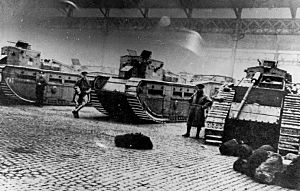Battle of George Square facts for kids
Quick facts for kids Battle of George Square |
|||
|---|---|---|---|
| Part of Red Clydeside | |||

|
|||
| Date | 31 January 1919 | ||
| Location | |||
| Caused by | A protest to shorten the work week led to a clash with police. | ||
| Resulted in |
|
||
| Parties to the civil conflict | |||
|
|||
| Lead figures | |||
|
|||
| Number | |||
|
|||
| Casualties | |||
| Many people were injured. One police officer later died from his injuries. | |||
The Battle of George Square was a large and violent protest that took place in Glasgow, Scotland. It happened in George Square on Friday, 31 January 1919, just after the First World War had ended. The event is also known as "Bloody Friday" or "Black Friday".
The protest involved striking workers who clashed with the City of Glasgow Police. The situation became so serious that a local government official, the Sheriff of Lanarkshire, asked for help from the military. In response, British Army soldiers and six tanks were sent to Glasgow. However, the soldiers did not fight the protesters. Some of the strike leaders were arrested for their role in the protest.
Contents
Why Did the Workers Protest?
After World War I ended in 1918, millions of soldiers began returning home. This meant there was a risk of mass unemployment because there were not enough jobs for everyone.
In Glasgow, workers' groups like the Scottish TUC and the Clyde Workers' Committee (CWC) had an idea. At the time, the normal work week was 47 hours long. They believed that if the work week was shortened to 40 hours, companies would need to hire more people. This would create jobs for the returning soldiers.
To achieve this goal, they decided to go on strike. A strike is when workers stop working to demand better conditions. The strike began on Monday, 27 January 1919.
Asking the Government for Help
On 29 January, the strike leaders met with the Lord Provost of Glasgow, the city's leader. He agreed to send a message to the British government in London, asking them to step in and help solve the dispute. The workers agreed to gather in George Square two days later, on Friday, 31 January, to hear the government's response.
The local Sheriff was worried that the large gathering might lead to trouble. He contacted the government to ask if he could get military support if needed.
The Clash in George Square
On Friday, 31 January, a huge crowd of 20,000 to 25,000 people gathered in George Square. When the protesters tried to stop the city's trams from running, the police moved in to clear a path. A violent clash broke out between the police and some of the protesters.
The fighting quickly spread and turned into a riot. The Sheriff of Lanarkshire officially requested military aid to restore order in the city.
The Army is Sent to Glasgow

The British government was concerned about the situation. At the time, revolutions were happening in other parts of Europe, and they feared the Glasgow strike could spread across the country. The government's Secretary for Scotland, Robert Munro, even called the protest "a Bolshevist uprising," comparing it to the recent revolution in Russia.
The government agreed to the Sheriff's request. About 10,000 soldiers, most of them from Scottish regiments, were sent to Glasgow. They also sent six tanks and 100 trucks.
It is important to know that the army arrived in Glasgow on the night of 31 January, after the riot in George Square had already ended. The soldiers and tanks never fought the protesters. Their job was to guard important buildings and help the police keep the peace. The troops remained in and around Glasgow until 18 February, when the strike was over and the city was calm.
What Happened Next?
After the riot, several of the strike leaders were arrested. Two of the main organisers, William Gallacher and Emanuel Shinwell, were found responsible for causing the unrest. They were sent to prison for several months.
Although the strike did not immediately achieve the 40-hour week, it had a big impact on Scottish politics. Many of the strike leaders became popular figures. In the general election of 1922, several of them, including Manny Shinwell and David Kirkwood, were elected as Members of Parliament.
This was part of a bigger change in the area around the River Clyde. The region became known for its strong support for socialist ideas and workers' rights. Because of this, it earned the nickname Red Clydeside.
Myths About the Battle of George Square
Over the years, many stories have been told about the Battle of George Square. Some of these stories are not entirely true. It is important to separate the facts from the myths.
- Myth: Winston Churchill, a famous politician, personally ordered English tanks to attack Scottish workers.
- Fact: The request for military help came from the local Sheriff of Lanarkshire, not from London. Churchill was not the person who made the decision to send troops. Also, the troops were sent to keep order, not to attack people.
- Myth: The government sent English soldiers because they feared Scottish soldiers would join the protesters.
- Fact: Most of the soldiers sent to Glasgow were from Scottish regiments, including the Gordon Highlanders and the Royal Scots.
- Myth: Tanks rolled through George Square to break up the protest.
- Fact: The tanks and soldiers arrived in Glasgow after the riot was over. The tanks were kept at a different location in the city and were never used against the crowds.
See also

